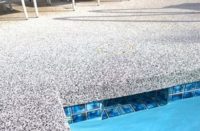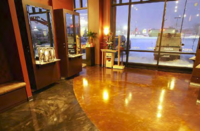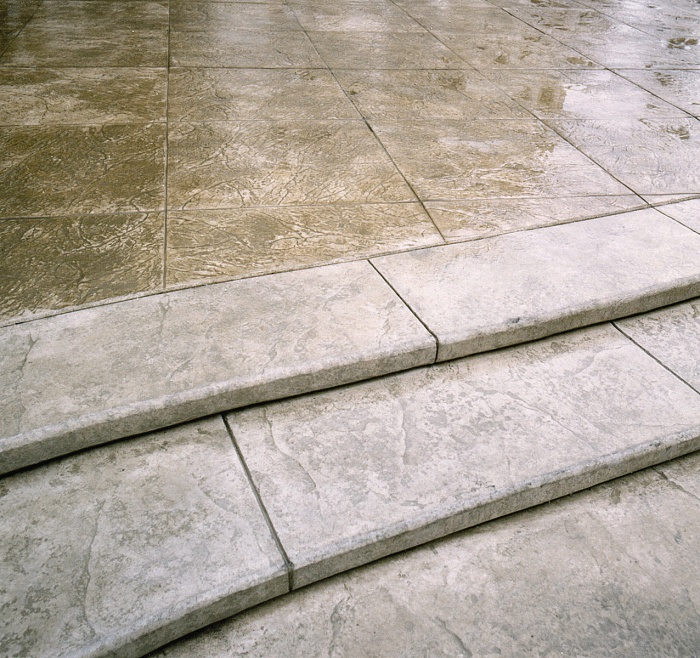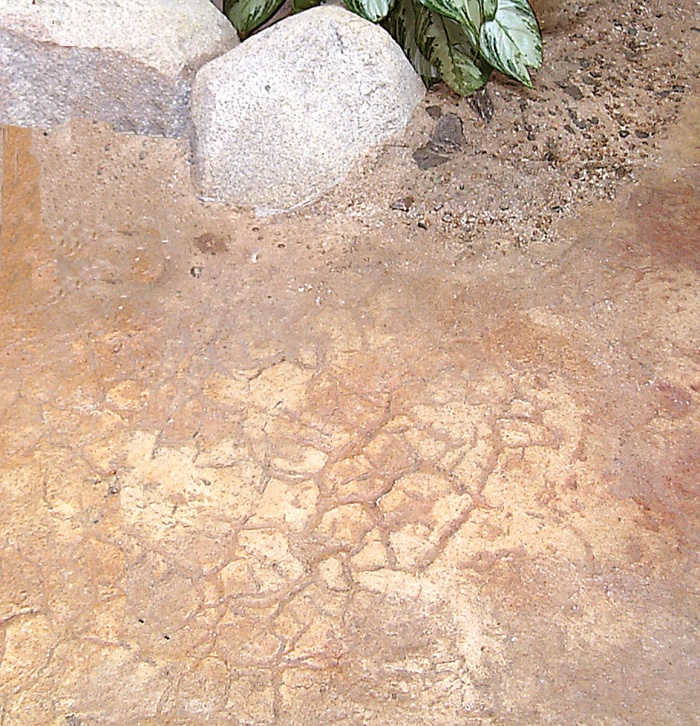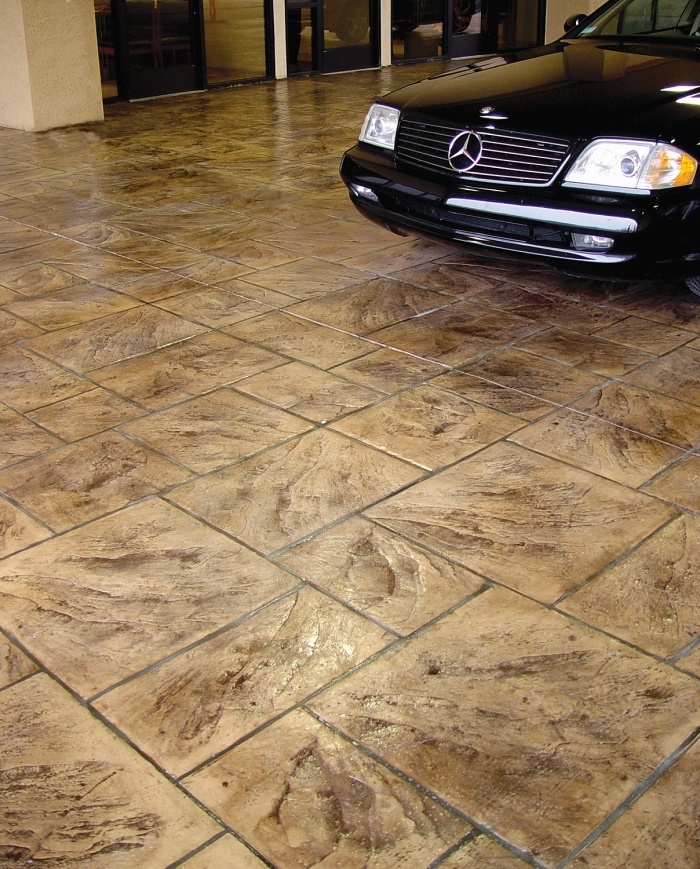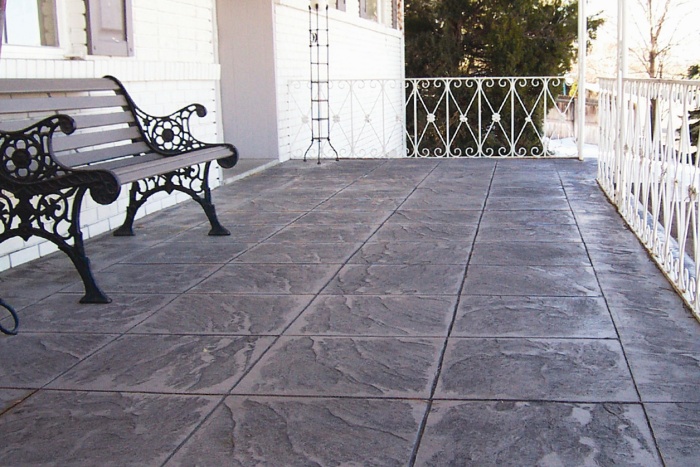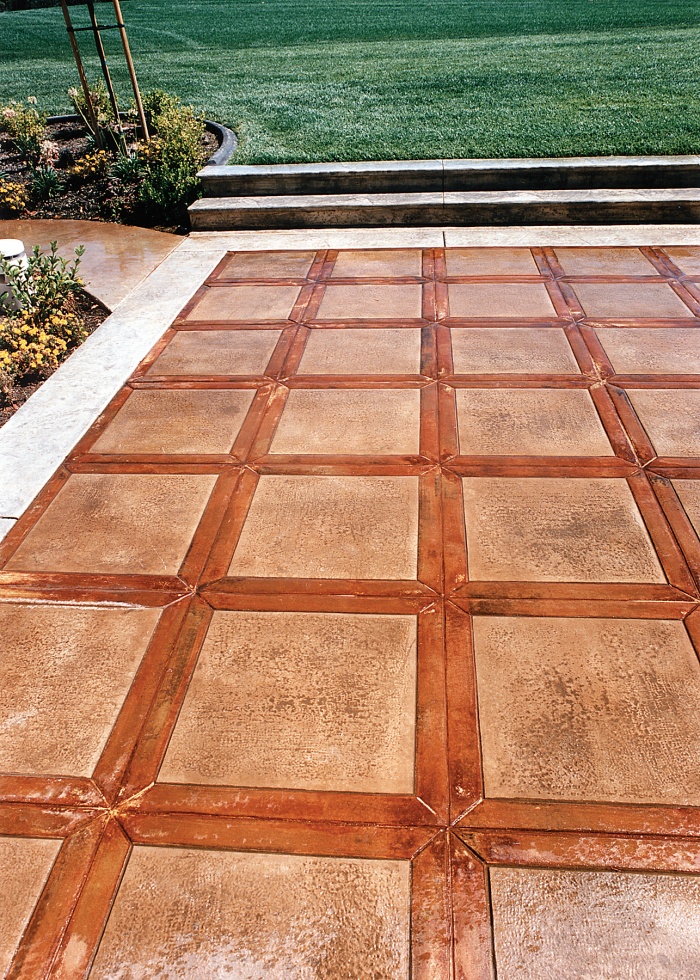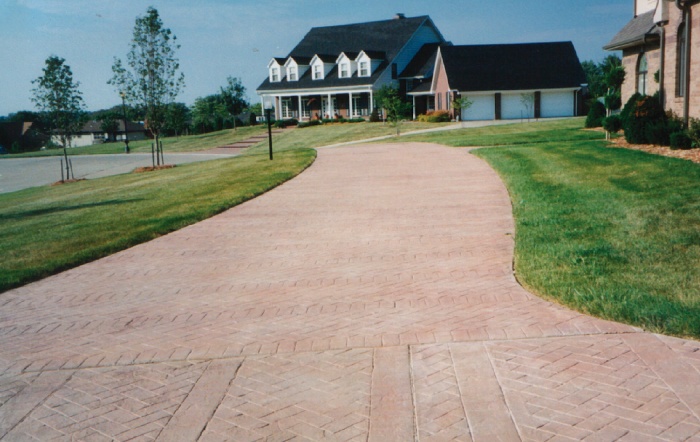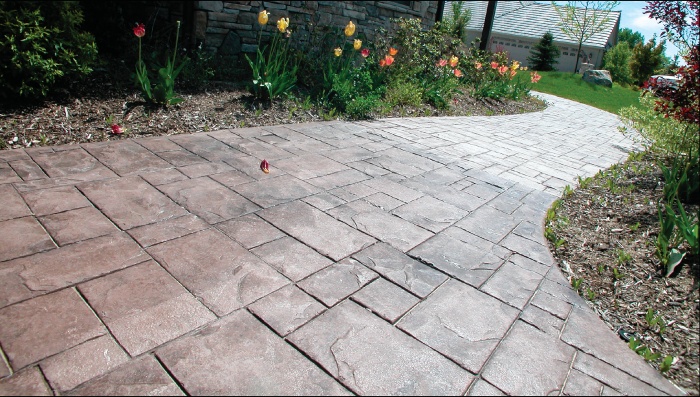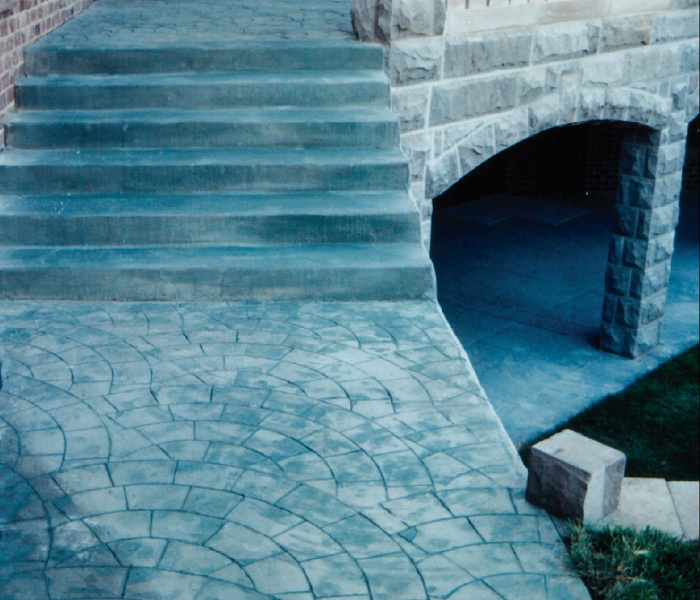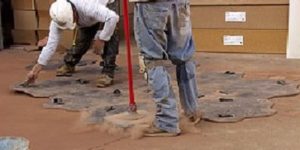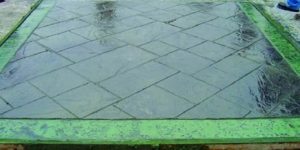If you want to impress gullible friends with the glamour and excitement of concrete contracting, tell them you work on a hands-on basis with “release agents.”
Only you will know the truth. Release agents are NOT highly trained government operatives who negotiate the exchange of political prisoners. They’re just powders and liquids.
But they do something that is just as thrilling, when it happens: They keep stamps from sticking to freshly poured concrete, insuring that every edge stays crisp when a stamp is pulled away.“ Its foremost purpose is primarily as a bond-breaker,” says Clark Branum, Northwest area manager with Rafco Products-Brickform.
Like many other tools of the decorative concrete trade, it also works well as an accent. Dark pigment added to a release agent will accumulate in the pits and valleys of a pressed design, such as the grout lines. The shadow effect makes grooves look deeper, corners more pronounced, and the whole pattern look more realistic. And older, which is why tinted release agents are especially helpful when antiquing.
But while both liquid and powder release agents separate stamp from concrete, only the powders come with color. Liquid release agents are usually clear. If you want to tint with them, you have to add the pigment yourself.
Liquid or powder?
Some manufacturers make only one or the other. Both have their uses. And just about everybody, it seems, has a preference.
“I like powder better,” says Paul Luckau, product manager for Cobblecrete International. “I just think it looks better. The transfer from stamp to concrete comes out more. With liquid releases, you don’t get the bite, the edge you get with powder.”
But Dan Cook, president of A.W. Cook Cement Products Inc., which makes CemTec products, favors liquids. “Liquid release is just a little bit cleaner,” he says. “You don’t have all that powder floating around everywhere.”
Liquid releases are easier to work with, primarily in the cleanup stage, because they evaporate on their own, he says. Powder releases have to be washed away, which can be reason enough by itself to choose liquid for interior jobs and remodels.
When it comes to color, Cook advocates using clear liquid release and tinting the sealer instead. “I think you get a little more control over antiquing if you do it as a second process,” he says. “You can see what effect you are getting as you antique. With powder, you really don’t know what you are getting until you wash the powder off the next day.”
Branum of Rafco-Brickform, which sells both liquid and colored powder releases, says liquids work better in confined spaces, environmentally sensitive areas, and any other job where cleanup is a factor. That includes a lot of overlay jobs, he says, because many are indoor projects.
But powders are better for antiquing jobs and exteriors, particularly in extreme conditions, he says. “You can build enough of a blanket that water won’t seep through.”
Liquid releases are becoming more popular, Branum says, but beginning stampers still tend to use powders. “Powders are more user friendly,” he says. “They’re easier to use than liquids, especially if you are trying to achieve highlighting.”
Chris McMahon, president of a Levittown, Pa., outfit that does business as Architectural Concrete Design, says weather influences his choice. “Liquids are great when they’re usable,” he says. “But in some environments, they don’t work as well as powder.”
High humidity can cause problems for liquids, as can cold, damp weather, McMahon says. “It all depends on the moisture level of the concrete. The surface has to be drier for liquids to work.”
But he uses liquids whenever he can, tinting them as needed, because they make for a much cleaner job, he says. “Liquid release is so much easier to use,” he says. “Powder is so fine that it becomes airborne. It adheres to stucco and plaster. It gets everything covered in color.”
Overlays are more controlled in terms of moisture levels, so liquid release works well on those jobs, he adds.
Powder release agents are composed of cement, iron oxide pigment for color, and moisture repellant that keeps the water in concrete from clinging to the stamp. It’s applied after the concrete slab has gelled but before final troweling.
Luckau recommends you sift the fine powder by hand before application to break up clumps. “It feels almost like silky water,” he says. “It’ll really fluff up.”
Broadcast the powder in an even coat, and stamp right away, Luckau says. The powder should be thrown sidearm, like skipping a rock across a lake. But for even better results, he says, whisk it sidearm with a 2-inch by 6-inch masonry brush. A bucket of release will last longer that way. “The powder will stick on the brush just like paint. It’ll just float right over the concrete.”
Using a brush will also help you avoid clumping, Branum says. The powder doesn’t throw as naturally as, say, aggregate-based color hardener. If you stamp a clump instead of concrete, you’ll be left with a bare spot.
With release, you want 100 percent coverage, he adds, not 60 percent to 65 percent like with color hardener.
Leave the powder on for two or three days after stamping, Luckau says, so the color gets a good bite into the surface. That way, you won’t wash the color away when you finally come back to clean off the powder.
Liquid releases, for their part, are solvents mixed with mineral spirits. CemTec’s liquid release is sold as a concentrate, with adding mineral spirits left to the contractor. It includes a fragrance to offset the smell.
Contractors have been tinting the clear, oily substance on their own for years. But Branum warns that there are no standards for this practice. “I wouldn’t say anybody has come up with a proper system for doing it,” he says.
When applying liquid, use a sprayer to coat the surface just ahead of the area that is being stamped. Don’t treat the whole slab at once, because the release will evaporate before you finish.
Most contractors fog both the mat and the concrete, Cook says. Texture mats are more forgiving than brick or cobblestone stamps, he says, so fog the latter more often.
“As long as you can’t see the concrete through it, it’s thick enough,” Luckau says.
If it’s a little uneven, don’t worry, Branum says. The worst thing that can happen is your stamp sticks a little. Then, you just fix it. “You don’t want to overapply,” he says. “You want to have a nice even coat on the surface.”
It’s also important to note proper stamping times, he says. If the concrete is too wet, it will cling to a stamp even after the application of release.
Whether powder or liquid, McMahon says, use as little as you can. “You don’t want too much powder because it takes away from the definition of the stamp,” he says. “You don’t want too much liquid because you don’t want to liquefy the surface. If the surface comes up, you have one of two things — too little or too much. A lot of guys put down more and more, and they are only making the problem worse.”
Many liquid releases take a while to dry, he adds, even to the point where you can’t cure-seal the job on the same day. “It needs to completely evaporate first,” he says.
Powder releases that are lighter than the base color can change the hue of the slab, Luckau says. Lay a film of light gray over red, for example, and you can end up with pink. Darker releases are required for antiquing and shadowing — say, dark brown, black or charcoal gray for a red base. “It’s like makeup,” he says. “A lady who wants to cover up things uses light. If she wants to bring out her cheeks, she uses dark.”
But a layer of lighter release can be buffed, McMahon says. Going over the surface afterward with a scrubbing machine, or simply letting wear and tear do the work, will allow the original color to bleed through. “You get a cool effect that way,” he says.
High humidity can cause problems for liquids, as can cold, damp weather, McMahon says. “It all depends on the moisture level of the concrete. The surface has to be drier for liquids to work.”
But he uses liquids whenever he can, tinting them as needed, because they make for a much cleaner job, he says. “Liquid release is so much easier to use,” he says. “Powder is so fine that it becomes airborne. It adheres to stucco and plaster. It gets everything covered in color.”
Overlays are more controlled in terms of moisture levels, so liquid release works well on those jobs, he adds.
Powder release agents are composed of cement, iron oxide pigment for color, and moisture repellant that keeps the water in concrete from clinging to the stamp. It’s applied after the concrete slab has gelled but before final troweling.
Luckau recommends you sift the fine powder by hand before application to break up clumps. “It feels almost like silky water,” he says. “It’ll really fluff up.”
Broadcast the powder in an even coat, and stamp right away, Luckau says. The powder should be thrown sidearm, like skipping a rock across a lake. But for even better results, he says, whisk it sidearm with a 2-inch by 6-inch masonry brush. A bucket of release will last longer that way. “The powder will stick on the brush just like paint. It’ll just float right over the concrete.”
Using a brush will also help you avoid clumping, Branum says. The powder doesn’t throw as naturally as, say, aggregate-based color hardener. If you stamp a clump instead of concrete, you’ll be left with a bare spot.
With release, you want 100 percent coverage, he adds, not 60 percent to 65 percent like with color hardener.
Leave the powder on for two or three days after stamping, Luckau says, so the color gets a good bite into the surface. That way, you won’t wash the color away when you finally come back to clean off the powder.
Liquid releases, for their part, are solvents mixed with mineral spirits. CemTec’s liquid release is sold as a concentrate, with adding mineral spirits left to the contractor. It includes a fragrance to offset the smell.
Contractors have been tinting the clear, oily substance on their own for years. But Branum warns that there are no standards for this practice. “I wouldn’t say anybody has come up with a proper system for doing it,” he says.
When applying liquid, use a sprayer to coat the surface just ahead of the area that is being stamped. Don’t treat the whole slab at once, because the release will evaporate before you finish.
Most contractors fog both the mat and the concrete, Cook says. Texture mats are more forgiving than brick or cobblestone stamps, he says, so fog the latter more often.
“As long as you can’t see the concrete through it, it’s thick enough,” Luckau says.
If it’s a little uneven, don’t worry, Branum says. The worst thing that can happen is your stamp sticks a little. Then, you just fix it. “You don’t want to overapply,” he says. “You want to have a nice even coat on the surface.”
It’s also important to note proper stamping times, he says. If the concrete is too wet, it will cling to a stamp even after the application of release.
Whether powder or liquid, McMahon says, use as little as you can. “You don’t want too much powder because it takes away from the definition of the stamp,” he says. “You don’t want too much liquid because you don’t want to liquefy the surface. If the surface comes up, you have one of two things — too little or too much. A lot of guys put down more and more, and they are only making the problem worse.”
Many liquid releases take a while to dry, he adds, even to the point where you can’t cure-seal the job on the same day. “It needs to completely evaporate first,” he says.
Powder releases that are lighter than the base color can change the hue of the slab, Luckau says. Lay a film of light gray over red, for example, and you can end up with pink. Darker releases are required for antiquing and shadowing — say, dark brown, black or charcoal gray for a red base. “It’s like makeup,” he says. “A lady who wants to cover up things uses light. If she wants to bring out her cheeks, she uses dark.”
But a layer of lighter release can be buffed, McMahon says. Going over the surface afterward with a scrubbing machine, or simply letting wear and tear do the work, will allow the original color to bleed through. “You get a cool effect that way,” he says.
